Textured rollers for painting walls. Review of stencils, rollers for decorative plaster and other tools
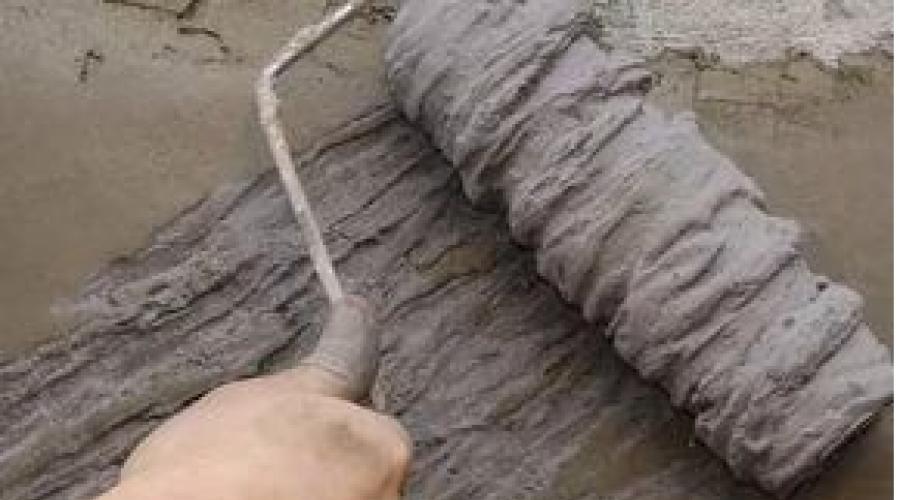
Decorative plaster is a common finishing material that allows you to obtain durable, wear-resistant coating. With its help, buildings are decorated both outside and inside. A relief roller for plaster creates impressions on its surface that imitate diverse different types surfaces. In this way you can recreate the texture of wood, stone, “fur coat” and many other types. The resulting coating gives an aesthetic, attractive appearance room, emphasizes the originality of the design.
Classification of rollers by contact surface material
Roller attachments for decorative plaster differ in the material from which they are made. Differences in the properties of contact surfaces ultimately affect the final result. A detailed classification according to this criterion is presented in the table.
| № | Tool attachment groups | Description, characteristics |
|---|---|---|
| 1 | rubber | they work primarily experienced craftsmen because it requires certain dexterity and skills |
| 2 | wooden | requires drying and cleaning after use, otherwise it swells and deforms, and then, once dry, may crack |
| 3 | made of plastic | cheaper substitute for rubber nozzles |
| 4 | leather | rollers with these attachments create marble-like final coatings, Venetian plaster |
There is a wide variety of bait textures. Some can be seen in this photo.
Types of attachments for rollers
Big choice rollers for application decorative coatings contributes to the implementation of a wide range of design solutions. You can quite easily choose a tool for a specific case.
Separation of tools according to the type of pattern they create
Plastering with a roller adds different patterns and textures to the surface. Depending on the patterns created and the clarity of the relief, rollers are divided into textured and structural. The effect achieved will depend on the type used.
Textured rollers for decorative plaster are tools that are used to create a design reminiscent of such common types of finishes as:
- fur;
- wooden;
- textile;
- marble and others.
Imitating the required relief is achieved by using nozzles with the appropriate coating. Examples of use for these purposes various materials the following:
- to obtain a “fur coat”, pile rollers with long threads are used;
- surface underneath a natural stone created with loop patterns on the contact part of the roller;
- Leather and fabric rollers for textured plaster allow you to achieve a marbled design.
The most realistic patterns are obtained when uniform movements tool. The working solution is directly applied to the surface using a device, and at the same time the required texture is created.
When decorating with such rollers, you must consider:
- with wide nozzles, the desired effects are achieved more easily;
- convexities on the working surface are created by the depressions of the contact part of the tool, and the depressions on it are created by its protruding elements;
- the plaster layer should be sufficiently plastic, but not flowing.
By width, textured products are divided into short (up to 0.3 m), medium (0.3-0.5 m) and long (more than 0.5 m).
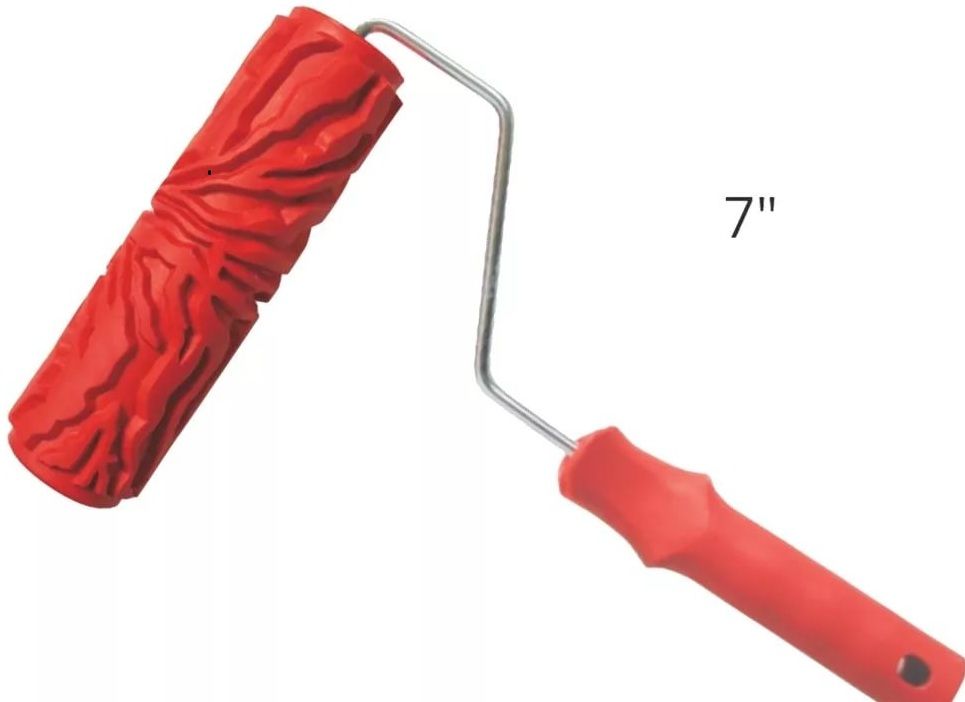 A good example structures
A good example structures Structural rollers for decorative plaster differ in that they are used after application finishing composition for the design of complex, repeating structures (ornaments, designs). The figure shows a possible appearance such tools.
In most cases, attachments for such rollers are made of wood or rubber. The ornament on them has clear contours and is closed in a circle throughout the entire working part.
This tool allows you to achieve various volumetric effects. It is often used when applying liquid composition on top of finished surface. Because the clear relief of the nozzle entails the formation of an uneven resulting coating. This is due to the accumulation of plaster in the roller cells.
You can avoid this kind of trouble by using a tool with a fine relief pattern or working on a dried layer.
Textured and structural bolsters allow you to achieve many different effects in interior design.
Making your own roller at home
You can make a roller for decorative plaster yourself. This solution will allow you to create a truly unique design, will encourage Creative skills. An exclusive look will be provided to the interior.
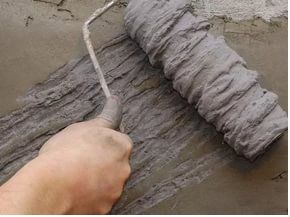 Example self-made roller
Example self-made roller Depending on what surface it is desirable to imitate, make
following:
- obtaining a wood texture for the walls is ensured by a rubber roller wrapped with a rope (it is better to glue it), and the turns of unequal thickness are laid in different directions;
- a plastic roller wrapped with a narrow tape of compacted fabric also allows you to achieve a “wood” look on the surface to be decorated;
- if you cover a smooth nozzle with fabric, a textile pattern corresponding to its texture will appear on the wall;
- Indentations and patterns can be cut out on replaceable foam parts, which will allow you to create images depending on your personal imagination, but you will need to work carefully.
The simplest option on how to make a nozzle with your own hands: you need to randomly wrap any existing roller with polyethylene, a rag, rope or strands. Individual results are guaranteed.
Techniques for working with decorative plaster
To apply decorative plaster with a roller, you will also need some other tools, such as a spatula, level, paint brushes, hard sponges, graters, smoothers. In addition to the mixture, you will need a resin-based primer.
All work is carried out according to a sequential scheme. Its main stages are as follows:
- prepare the walls: clean them of dirt, old coating, exfoliated fragments and prime them;
- the working surface is plastered with the first layer until leveled and painted if necessary;
- the next layer (after the previous one has dried) is applied with decorative plaster of the required density;
- with a tool with textured or structural attachments, a design can be quickly drawn up;
- After 20 minutes, blemishes are removed from the surface moistened with water using a trowel;
- they clean it up in two days minor defects and do the painting.
The photo shows the process of creating the design.
It is more efficient to perform plastering with two people: one applies the plaster, and the other gives the required decorative look surfaces.
The compositions should be applied with structural rollers without overlaps, next to the previous passes. When working with a tool with a textured coating, strong pressure is not required: the less pressure, the greater the effect. All movements must be carried out evenly, smoothly and as continuously as possible from the ceiling to the floor.
The nuances of applying coating using a roller
Applying plaster with a roller must be accompanied by compliance with certain rules. Work should be carried out as carefully as possible. The nuances of decoration come down to the following principles:
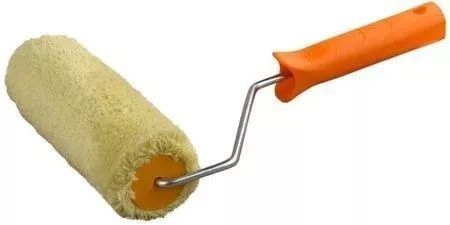
Following the simplest rules allows you to apply the decor yourself in the shortest possible time. The main thing is to constantly monitor the drying of the plaster solution.
Textured plaster is created quickly with a relief roller. This method of decoration makes it possible to decorate with a pattern. large areas walls To achieve a unique result in the shortest possible time, necessary A complex approach to the whole process. It consists in following the application technology, making the right choice working tool, use of finishing material High Quality. A big plus is the opportunity self-execution all work and production of tools for applying decorative plaster.
An example of working with a relief roller is presented in detail in the video.
Interior decoration is interesting and exciting process, for which you will need to show all your imagination and creativity. Thanks to the decoration of the walls, you will get a stylish and extraordinary interior that will embody the individuality of the owner. Recently, stencils are increasingly being used to create DIY decor. One of the most good options is the use of a stencil roller. This tool can be purchased in an online store or in specialized stores.
Patterned rollers are increasingly being used to create DIY decor.
Advantages of decorating with stencils
Important positive qualities Such decoration is considered to be easy to create and economically accessible. Using this technique, you can create a bright and extraordinary interior even against the backdrop of the most boring walls. In addition, stencil rollers help to focus attention on a specific area without overwhelming the space extra items interior As a result, you will be able to add additional notes of comfort and coziness to your interior.
Stencil decor can be applied to any type of wall surface, including tiles, glass, ceramics or plaster. Also, a beautiful ornament will help decorate not only the walls, but also the ceiling, floor, furniture and other interior items.
Main positive qualities:
- Creation original design, in which you can combine various elements decor with each other.
- Ease of use makes it easy to solve any problem. With the help of a stencil roller, anyone can quickly and accurately apply decor to the desired surface.
- The versatility of the stencil paint roller allows you to apply decor to any surface, which can be not only smooth, but also convex. Elastic templates are used to apply patterns on a convex surface.
- Economic accessibility is due to the fact that stencil rollers are much cheaper to use than to pay for the services of a professional artist.
- Convenience of decorating damaged wall surfaces.
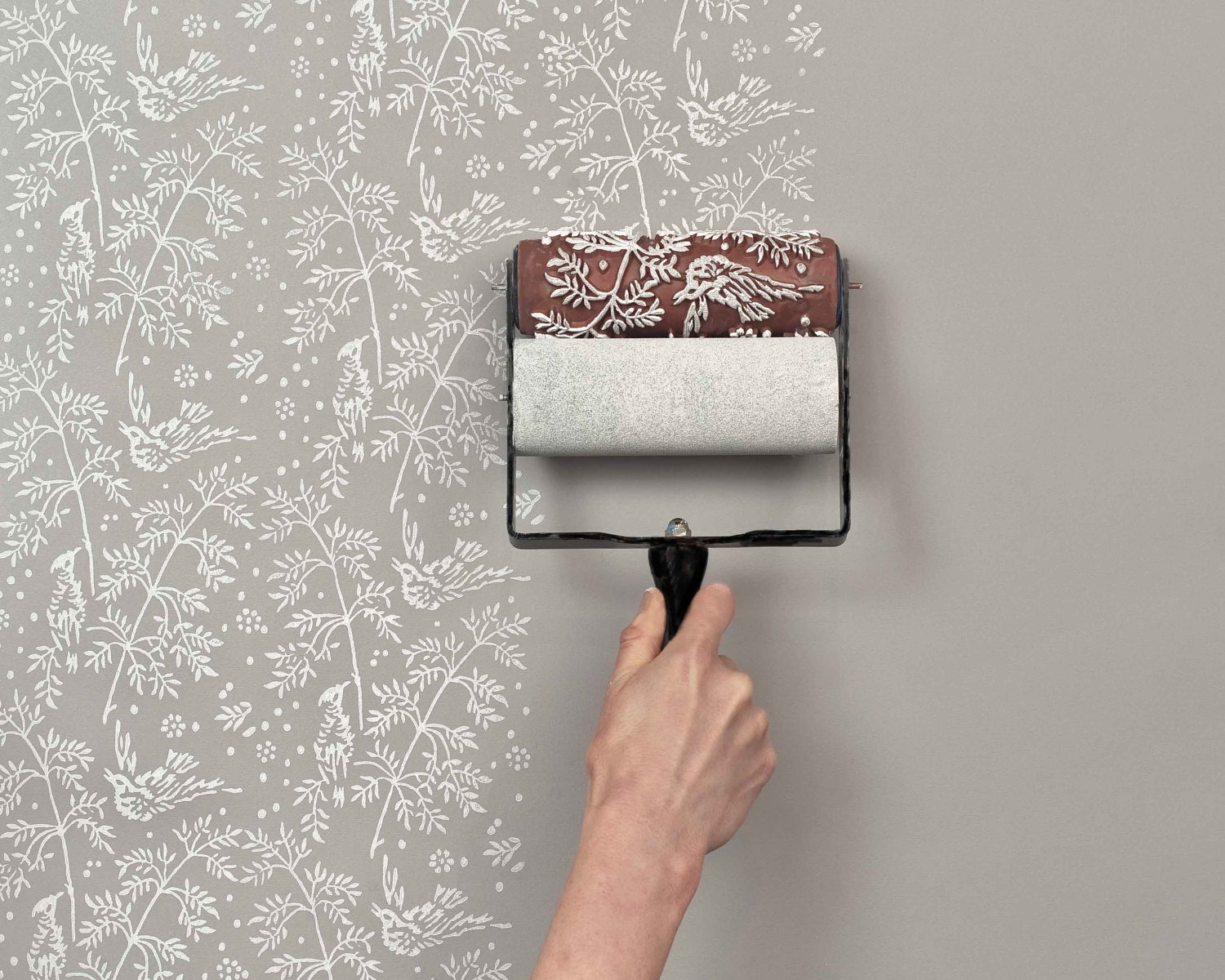 Stencil decor can be applied to any type of wall surface
Stencil decor can be applied to any type of wall surface Method of use
Stencil rollers are great for beginners, as working with them allows you to avoid unnecessary smudges paint and varnish materials. As a result, the ornament will be neat and uniform, without sharp transitions of shadows and shades. Although, the decor may not look as artistic as if it were made with a brush. At the same time, it is much easier to make it.
When working with this stencil tool, you can use many available tools, which allows you to save a lot.
For example, paint can be mixed in disposable bowls or other plastic containers. In this case, you can take an ordinary household sponge that is suitable in size. To remove excess paint, you can use disposable paper napkins or towels.
Roller knurling rules
To use stencil rollers more efficiently, it is best to make a special device in the form of a machine consisting of two rollers. One roller will contain a rubber stencil, and the second should be smooth, made of porous rubber or a rubber sponge. They should be pressed tightly together so that they rotate freely.
Before starting work, the roller is soaked in paint, after which the excess paint is squeezed out. Next, the roller is inserted into the machine and work begins. After this, the machine is placed with a stencil roller on the surface to be painted. To apply decor efficiently, you should apply a certain amount of pressure while moving the roller along the wall.
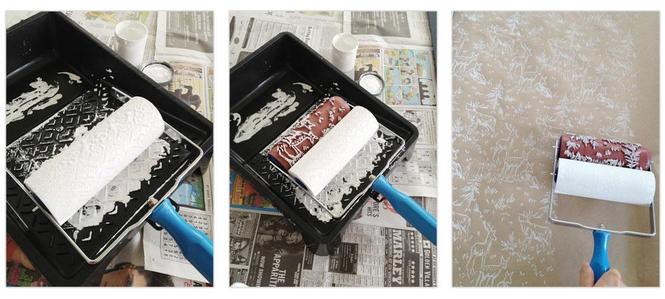 Effective use screen rollers
Effective use screen rollers For ease of use, you can supplement a machine with two rollers with a paint reservoir, which will constantly supply paint to the tool with a stencil. This addition allows you to paint for much longer. The design of the machine makes it possible to adjust the pressure that is used to press the rollers against each other. Thanks to this, you can change the saturation of the pattern and make it the same over the entire surface of the walls.
This technique is called the color knurling technique. Using stencil rollers, you can achieve a crumpled surface effect that will add originality to your interior.
Types of stencils
Today, there are many varieties of stencils that will allow you to create bright and extraordinary designs. Main types:
- multi-color, with the help of which you can get a multi-color bright pattern;
- plain, creating an ornament of one color, which are considered the most common;
- volumetric, in which putty is additionally used.
Choosing a stencil depending on the interior features
When choosing a design when decorating with a stencil roller, it is recommended to take into account individual wishes and general style interior Basic tips for choosing stencils:
- Before choosing a stencil, you should design the overall style of the interior. Decor patterns should be in harmony with it so that there is no unfortunate combination of different styles.
- It is desirable that the decorated pattern be as restrained as possible and not contain too many small or overly bright details.
- When creating decor stencil method It is recommended to choose templates with big amount various jumpers and thin elements. Such designs look very elegant and beautiful.
Stencil rollers for home interior decoration
Bathroom decoration
Stencil decoration of a bathroom will look very original; it can be decorated with various interesting ornaments, which will make the room more comfortable and extraordinary. For example, you can decorate the wall in oriental style. To complete created image, preferably individual elements repeat this ornament on the frame and even on the mirror.
Such stencil decorations will look good not only on ceramic tiles, but also on a European board. At the same time, working in rooms with high humidity It is advisable to use acrylic-based paints, which have increased resistance to moisture.
Latex, epoxy or alkyd compounds are also suitable as.
Drawings made using a stencil roller can be made not only on the surface, but also on plumbing fixtures such as washbasins or bathtubs. In addition, the ornament and design applied to the walls of the shower stall will look very original.
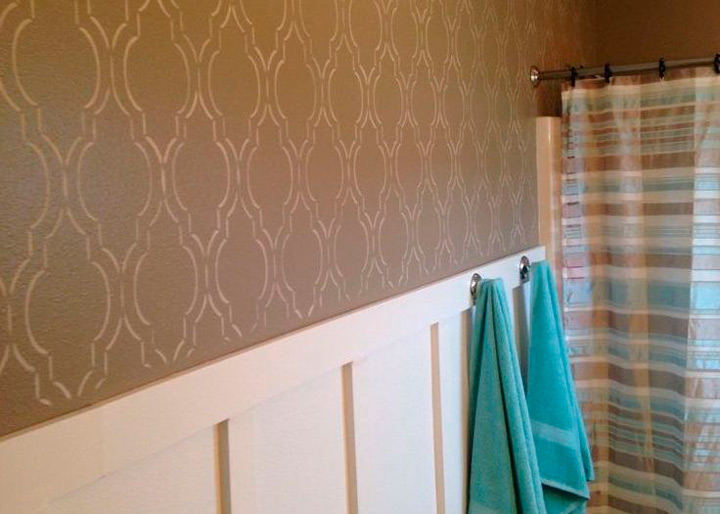 The bathroom can be decorated with various interesting ornaments
The bathroom can be decorated with various interesting ornaments Stencil decor in the hallway
Stencil decor will look no less relevant in the hallway. This room immediately welcomes guests, so its design leaves the greatest impression. Depending on the size of the hallway, it can be decorated with large ornaments or medium-sized designs. They can be applied both in the center of the walls and in their upper part. You should also use stencil rollers for this.
Decorating the kitchen and living room
The living room and kitchen are considered key rooms in any home where all family members gather to socialize. Therefore, the interior design of these rooms is especially important. With the help of stencil decor, you can create a warm and cozy atmosphere, applying beautiful and bright drawings to the walls. Using stencil rollers, you can refresh your interior even without replacing furniture.
Conclusion
Thus, using a stencil roller you can make original decor interior Moreover, working with this tool does not require special skills or significant economic costs.
Decorative plaster has firmly taken its place of honor among other wall finishing options. It is durable, beautiful, original, effective. Rollers for decorative plaster are largely “responsible” for these advantages. They allow you to create unusual designs, decorate a room, and give it original look. Externally, this decor is somewhat reminiscent of plaster stucco.
At first, the main method of decorating plaster was painting. For this purpose they used paint rollers with a fur coat. With the advent of new application techniques, changes to the tools were required. New types of rollers do an excellent job of this: textured, embossed, structural. This division is quite arbitrary, since the principle of their operation is very similar. The range of materials from which they are made has expanded significantly: foam rubber, rubber, polystyrene foam, leather. Less commonly, rollers are carved from wood.
A special feature of rollers for surface decoration is the ability to imitate different materials: marble, brick, wood. With their help, simple and complex patterns are applied, imprinting them on the prepared coating. Different indentation forces and the degree of relief expression allow you to make the design more expressive and give it depth.
To create an imitation of the selected material on plaster, you need to choose the right roller. If the print must protrude above the surface, then use a roller with indentations. By rolling it over the coating, the selected pattern is obtained. The maximum effect from roller processing is achieved when using compositions with fine filler.
A textured roller allows you to squeeze out a relief pattern. For example, to recreate brickwork, use a rubber roller without recesses and relief. Two channels are made on it, encircling the surface in a circle. So it's Workspace turns out divided into three parts. Then transverse grooves are made on each, and they are arranged in a checkerboard pattern. By running a roller over the solution, rectangular impressions are obtained, which will become bricks. There are ready-made rollers that allow you to create different types of brick rows.
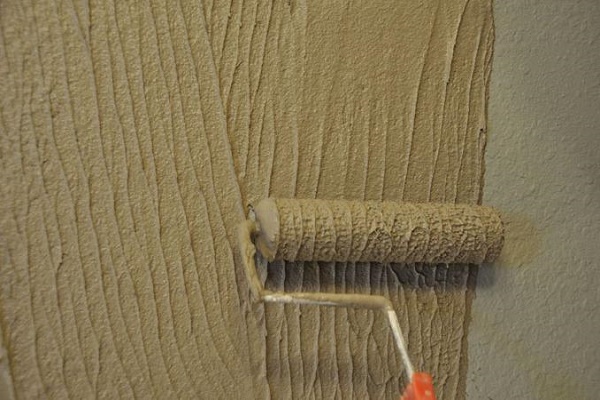
It is easy to create an imitation of marble on a plastered wall. To do this, you will need a roller made of fabric or crinkled leather. The main condition for achieving the desired effect is the uniformity of movements when rolling over the surface. In addition, you should try not to tear off the tool as long as possible.
You can make a textured surface on a roller yourself. To do this, take a rubber structural roller and wrap it with a rubber band. The turns can be made in any direction. With its help, the structure of wood fibers is recreated on the surface. For greater reliability, the location of the turns should be changed during operation.
Another option for improving a regular rubber roller involves gluing a piece of coarse fabric onto it. This simple device allows you to obtain a coating that imitates textile upholstery.
The craftsmen's favorite tool is a foam roller. Its surface is easy to process, allowing you to get any pattern. The beauty of decorating with a roller lies precisely in the ability to realize any creative ideas without much investment. So, a unique pattern can be created using a regular bag or mesh bag. They are wound onto a base, secured with glue or tape, and rolled along the wall.
Creating a structural surface
The peculiarity of structural rollers is that decorative effect primarily achieved due to the characteristics of the plaster. The presence of various fillers in it helps them, after rolling with a roller, to express themselves and play in a new way.
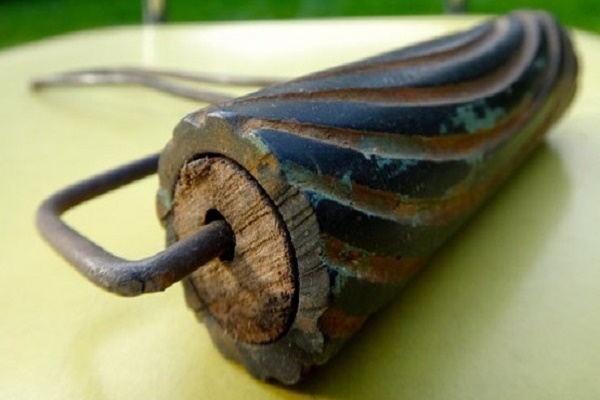
For work, different types of rollers are used: soft (made of foam rubber and polyethylene) and hard (made of rubber and plastic). The principle of their operation is similar to applying a stamp. By pressing with a roller while processing the surface, the pattern is transferred to the wall. The application technique does not depend on the type of roller, but the effect is different. Therefore, the question often arises about which roller to choose?
Soft rollers provide light, barely noticeable relief. They are often used by novice craftsmen, because it is difficult to damage the wall with them. Disadvantages of this tool:
- fragility;
- inability to perform complex drawings;
- the need to frequently wash the instrument.
Rigid materials are more convenient to work with and allow you to convey the design more clearly. Their only disadvantage is their higher cost.
Amateur craftsmen and even professionals often use homemade tools. This is due not only to the desire to save money, but also to the opportunity to get a truly original coating.
Simple structural rolls are made by winding fabric or thick threads around a base. More complex drawing You can first create it on a computer, and then use the pattern to transfer it to thick rubber. It is then glued onto the roller.
Features of use
Regardless of the type of roller, the wall surface must be prepared before processing. First apply finishing coat, decorative plaster on it. The color of the layers may vary in shade.
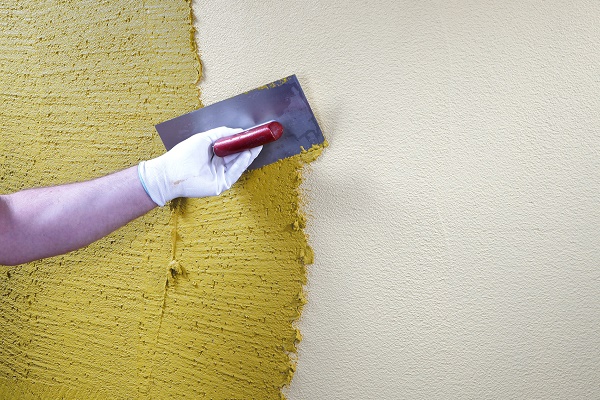
When making a pattern, do not press too hard on the tool. The result may not be original surface, and areas only partially covered with plaster. You need to work with the tool smoothly, with sliding movements.
The main task when working with a roller is to create a clear relief imprint. To do this, they need to move evenly, from top to bottom. The drawing should not be interrupted, so next page start exactly where the previous one ended.
Applying the pattern begins 10-12 minutes after plastering. The solution should dry slightly, then it will not stick to the tool or clog the pores of the roller.
What does the resulting effect depend on?
Rollers for decorative plaster allow you to create floral patterns, masonry, various patterns. To do this you need to choose the right tool. Conventionally, all of them can be divided into the following types:
- with depressed relief – leaves a convex pattern on the surface;
- with a convex relief - helps to imitate various materials;
- with pile - creates an original fur coat.
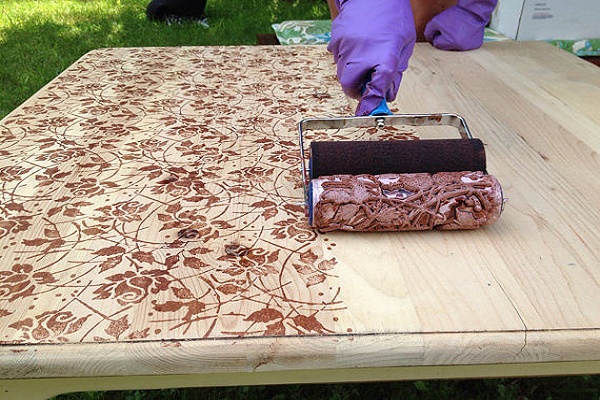
A short pile will provide an even coating, while a long pile will provide an uneven coating. If the pile surface is tied with several strips of twine, you will get a multi-level roughness with a directional pattern. You can cut the pile into grooves or spots, making the relief of the “fur coat” more complex and delicate. To squeeze out a pattern on the wall, you will need a roller with a convex image. If a pattern of droplets in the form of ears is applied to the working surface of the instrument, then the structure of natural stone will be obtained on the plaster.
The possibilities for creativity are unlimited. The main thing is not to overdo it with originality. It is not recommended to apply different patterns side by side - such a “composition” looks ugly.
A structural roller for decorative plaster is a tool necessary for anyone who is interested in a perfect renovation and plans independent finishing interior or facade of the house using modern means. To create exclusive design, it is enough to choose a model designed to achieve the desired surface relief of the walls using plaster mixtures or structural paints, V large assortment offered by our online store.
Rollers with decorative pillows You can buy it together with finishing materials. A wide selection of tools designed for different effects allows you to implement any design idea With excellent result even without the involvement of specialists. But the abundance of products with different work surface may cause difficulties in determining the model necessary to implement the plan. Our consultant is always in touch to help you choose a roller that is ideal for realizing your idea.
Structural rollers with decorative cushions for plastering and painting walls
Decorative roller thanks to the relief pattern on the pillow, it allows for uniform, quick and economical application to the surface textured plasters and paints for finishing walls and facades. With the help of the right tool, it is easy to give the coating the desired effect, even without serious professional skills. Depending on the chosen cladding method, rollers with a working surface made of different materials are used:Hard rubber with relief;
porous polyurethane foam;
woven foam rubber;
leather, suede or velor;
twisted polyethylene;
synthetic sea sponge;
cotton fiber;
natural and artificial fur.
To buy textured rollers for decorative plaster without making a mistake with your choice, you need to pay attention to the manufacturer’s recommendations regarding finishing materials, for which a certain model is suitable for application. To work with plaster mixtures It is most convenient to use rubber products with a hard relief surface, the variety of which allows you to achieve original effects without spending high-quality finishing smooth walls extra effort.
Rollers for decorative painting walls today are made not only from traditional foam rubber. When using structural paints, similar results can be achieved using more practical cushions made from other porous materials. Polyurethane foam or sea sponge are suitable for simulating marble, stone or shell coatings. To create smooth or textured painted surfaces, leather, velor and even polyethylene products are no less successfully used.
How to profitably buy textured rollers for decorative plaster in Moscow
The most reliable way to buy rollers for decorative plaster in Moscow is in a specialized online store that offers facing materials from leading manufacturers as an official dealer. The Favorit company sells popular products for stylish finishing of premises and facades throughout the country, taking full responsibility for their quality.The regularly updated catalog also includes tools that are optimally suited for working with the offered paints and plasters. Here you will find not only a decent selection of rollers according to affordable prices, but also detailed information on the use of modern finishing materials. Detailed consultations for customers are free. Call!
Covering walls with decorative plaster is not as complicated and not as expensive a process as it may seem to uninformed people. But, firstly, even a beginner can do it with his own hands, and secondly, there is no need to wrap any more fur roller threads or some other sophisticated way, you can already buy a ready-made roller with a certain relief.
The trend towards using rollers came to us from Europe, where they began to be used so that three-dimensional images could be made on the wall. They resembled plaster moldings.
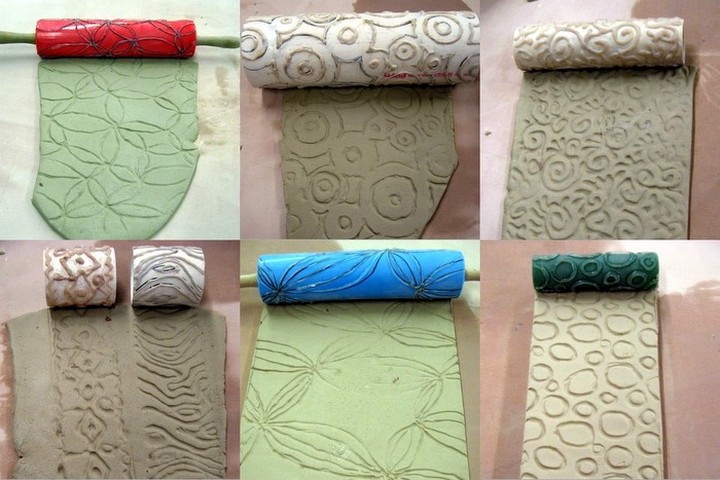
A roller is a tool that consists of a coated cylinder and a handle. The base of the cylinder can be rubber, metal, silicone or plastic. And the covering can be fabric or foam rubber. You can find both leather rollers and wooden ones (handmade).
Once upon a time, imprints were applied to wallpaper for painting using a textured rubber roller, but since wallpaper is now produced with a ready-made pattern, rollers are used for a different purpose.
Applying “Shuba” plaster with a roller: stages
“Fur coat” is a fairly economical type of finishing. Modern plasters“fur coat” – elastic, strong, breathable and durable. This coating is applied to durable, smooth, mineral substrates. These are brick, concrete, cement, plaster, facade putty.
If you are interested in the most a budget option such plaster, then purchase it in bags, dry. The dry “coat” is made of cement, which is a fragile material with low elasticity. Therefore, if microcracks appear on the walls, the wall will immediately crack. But the “fur coat” on acrylic copolymers stretches and is more elastic.
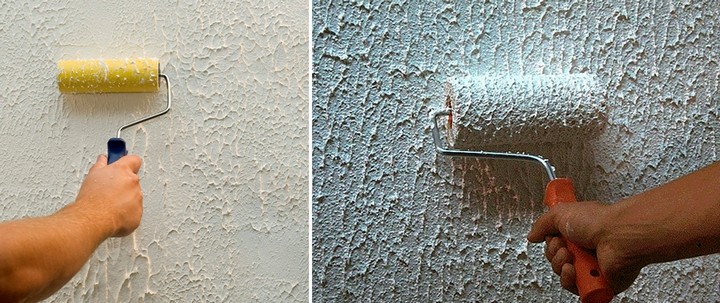
How to apply a fur coat with a roller:
- First, the plaster is applied in a thin, even layer, and then it is rolled over the damp surface with a roller.
- When the solution itself is being applied, you can see that in some areas the “fur coat” turns out to be larger, then with a slight movement of the spatula the material needs to be distilled to those places where there is a smaller pattern, and there you roll it.
- Apply the material with a roller from corner to corner, without interruption, so that there are no joints.
If you are applying for the first time, it makes sense to practice small area. If you have already noticed uneven application, move the roller from areas where the texture is large towards a smaller texture. Then it will be distributed more evenly.
Applying “fur coat” plaster with a roller (video)
Types of rollers
There are a lot of rollers, and each of them makes applying the mixture not only an effective event, but also fun.
![]()
Types of rollers:
- Model with pile. It imitates a fur surface. The future ornament depends on the type of pile on the roller, its length and thickness. Long pile makes the plaster porous, and short pile makes it smoother.
- Relief roller with convex fibers. It helps create a wavy relief.
- Plastic nozzles with holes. The result will be a relief surface with alternating grooves and protrusions.
- Roller with loops. Helps in simulating the texture of natural stone.
- Rollers with convex clear ornaments. They are applied by certain resources.
- Roller with transverse grooves in a checkerboard pattern. Helps in simulating brickwork.
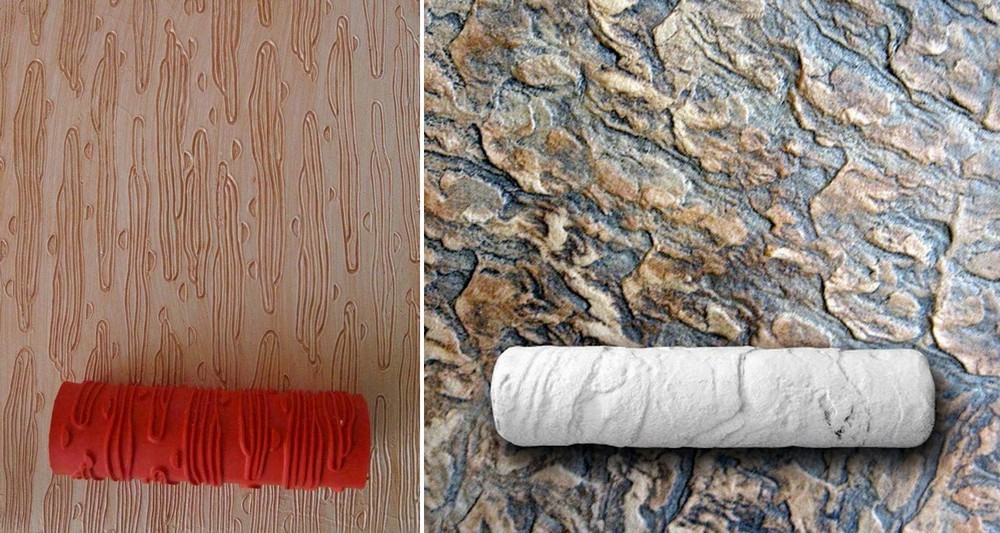
As in the case of “shuba” plaster, it is better to practice on some area, you will understand exactly how to work with a roller, what movements create the desired effect.
Is it possible to make a roller yourself?
Of course you can. For example, buy a regular, cheapest rubber roller. You will also need a thick rope, leather strips and glue.
Cut out a shape from leather or rubber, choose its shape yourself from the base, and you will see the print on the wall. Glue the figures at some distance from each other so that the relief on the surface is clear. The edges of the nozzle should be decorated as equally as possible.
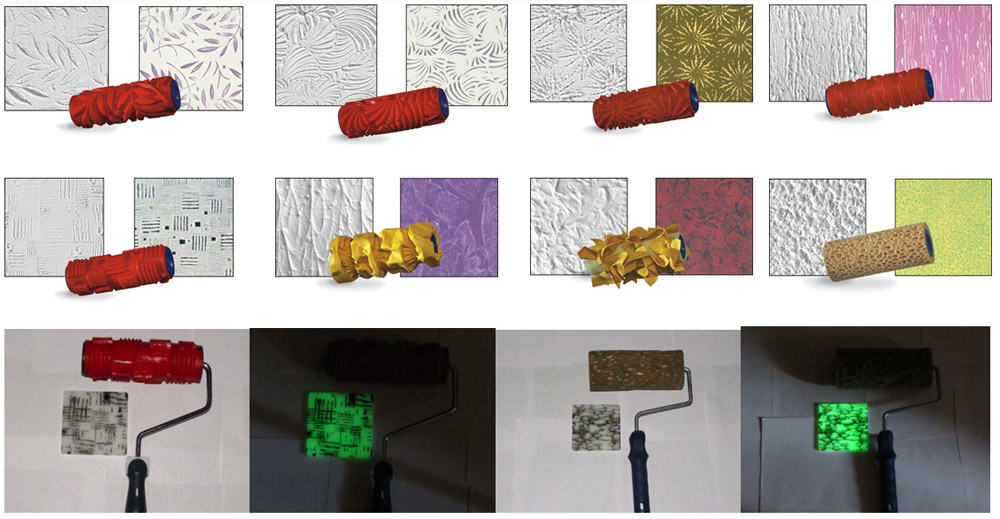
To apply plaster with a roller, you need:
- Remove the old coating from the wall and repair problem areas;
- If several colors are used in the decoration, the plaster is applied in several layers, where the first is a rough layer, the second is of one color, the third is of another, etc.
- To clearly separate the palette, use masking tape.
- Decorative plaster takes 20 minutes to dry, so apply it in small sections.
- Press the roller equally; the speed of the roller and the direction should be the same. If the convex parts of the pattern are very rough, they are corrected with foam rubber or a brush.
You can paint the wall surface after two days.
In addition to rollers, you can use brushes, fabrics, sponges, with their help it is possible to create an equally interesting relief.
Do-it-yourself decorative plaster with a roller (video)
Rollers for decorative plaster - wonderful, inexpensive way transform the walls in the room.
Attention, TODAY only!